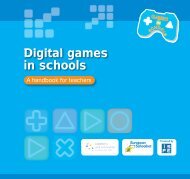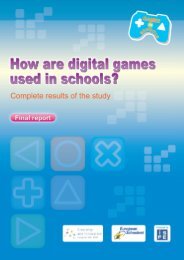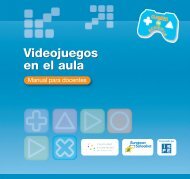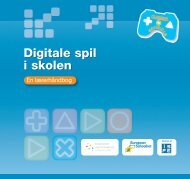Quels usages pour les jeux électroniques en classe ? - Games in ...
Quels usages pour les jeux électroniques en classe ? - Games in ...
Quels usages pour les jeux électroniques en classe ? - Games in ...
You also want an ePaper? Increase the reach of your titles
YUMPU automatically turns print PDFs into web optimized ePapers that Google loves.
Project Tomorrow, (2008). Speak Up 2007 for Stud<strong>en</strong>ts, Teachers, Par<strong>en</strong>ts & School Leaders Selected<br />
National F<strong>in</strong>d<strong>in</strong>gs - April 8, 2008. Retrieved from http://www.tomorrow.org/docs/National<br />
F<strong>in</strong>d<strong>in</strong>gs Speak U 202007.pdf<br />
Qu<strong>in</strong>n, C. N. (1997). Engag<strong>in</strong>g learn<strong>in</strong>g. Paper pres<strong>en</strong>ted at the Instructional Technology Forum.<br />
Ramsberger, P. F., Hopwood, D., Hargan, C. S., & Underhill, W. G. (1983). Evaluation of a spatial data<br />
managem<strong>en</strong>t system for basic skills education. F<strong>in</strong>al phase 1 report for period 7 October 1980–<br />
30 April 1983. Alexandria, VA: Human Resources Research Organization.<br />
Redd, W. H., Jacobs<strong>en</strong>, P. B., DieTrill, M., Dermatis, H., McEvoy, M. & Holland, J. C. (1987). Cognitiveatt<strong>en</strong>tional<br />
distraction <strong>in</strong> the control of conditioned nausea <strong>in</strong> pediatric cancer pati<strong>en</strong>ts receiv<strong>in</strong>g<br />
chemotherapy. Journal of Consult<strong>in</strong>g and Cl<strong>in</strong>ical Psychology, 55(3), 391-95.<br />
Reese, D. (2007). First Steps and Beyond: Serious <strong>Games</strong> as Preparation for Future Learn<strong>in</strong>g. Journal of<br />
Educational Multimedia and Hypermedia (2007) 16(3), 283-300<br />
Rice, J. (2007). New Media Resistance: Barriers to Implem<strong>en</strong>tation of Computer Video <strong>Games</strong> <strong>in</strong> the<br />
Classroom. Journal of Multimedia and Hypermedia (2007) 16(3), 249-61.<br />
Roll<strong>in</strong>gs, A., & Morris, D. (2000). Game Architecture and Design. Scottsdale, Arizona: Coriolis.<br />
Rosas, R. (2003). Beyond N<strong>in</strong>t<strong>en</strong>do: A design and assessm<strong>en</strong>t of educational video games for first and<br />
second grade stud<strong>en</strong>ts. Computers & Education, 40, 71-94.<br />
Rosser, J. C., Lynch, P. J., Cuddihy, L., G<strong>en</strong>tile, D. A., Klonsky, J., & Merrell, R. (2007). The impact of video<br />
games on tra<strong>in</strong><strong>in</strong>g surgeons <strong>in</strong> the 21st c<strong>en</strong>tury. Archives of Surgery, 142(2), 181-86.<br />
Rub<strong>en</strong>, B. D. (1999). Simulations, games, and experi<strong>en</strong>ce-based learn<strong>in</strong>g: The quest for a new paradigm for<br />
teach<strong>in</strong>g and learn<strong>in</strong>g. Simulation & Gam<strong>in</strong>g, 30, 498-505.<br />
Sal<strong>en</strong>, K. (2007). Gam<strong>in</strong>g Literacies: A Game Design Study <strong>in</strong> Action. Journal of Educational Multimedia and<br />
Hypermedia (2007) 16(3), 301-22.<br />
Sal<strong>en</strong>, L. & Zimmerman, E. (2003). Ru<strong>les</strong> of Play, Game Design Fundam<strong>en</strong>tals (pp. 80-94). Cambridge and<br />
London: The MIT Press.<br />
Seagram, R. & Amory, A. (2004). Design<strong>in</strong>g Effective Stories for Educational <strong>Games</strong>. In P. Kommers & G.<br />
Richards (Eds.), Proceed<strong>in</strong>gs of World Confer<strong>en</strong>ce on Educational Multimedia, Hypermedia and<br />
Telecommunications 2004 (pp. 162-167).<br />
Shaffer, D. W. (2006). How video games help childr<strong>en</strong> learn. New York: Palgrave Macmillan.<br />
Siem<strong>en</strong>s, J. (2007). Digital natives and immigrants: A concept beyond its best before date. Retrieved from<br />
http://connectivism.ca/blog/2007/10/digital_natives_and_immigrants.html<br />
Sor<strong>en</strong>s<strong>en</strong>, B. & Meyer, B. (2007). Serious <strong>Games</strong> <strong>in</strong> language and learn<strong>in</strong>g – a theoretical perspective.<br />
Digital <strong>Games</strong> Research Association 2007 Confer<strong>en</strong>ce: Situated Play, Tokyo, 559-66.<br />
Sprague, D. (2004). Technology and Teacher Education: Are we talk<strong>in</strong>g to ourselves. Contemporary Issues<br />
<strong>in</strong> Technology and Teacher Education, 3(4), 353-61.<br />
Squire, K., Barnett, M., Grant, J. M., & Higg<strong>in</strong>botham, T. (2004). Electromagnetism supercharged! Paper<br />
pres<strong>en</strong>ted at the International Confer<strong>en</strong>ce of the Learn<strong>in</strong>g Sci<strong>en</strong>ces 2004, Los Ange<strong>les</strong>.<br />
Stev<strong>en</strong>s, D. A. (2000). Leverag<strong>in</strong>g technology to improve test scores: A case study of low-<strong>in</strong>come Hispanic<br />
stud<strong>en</strong>ts, International Confer<strong>en</strong>ce on Learn<strong>in</strong>g with Technology. Temple University.<br />
160






